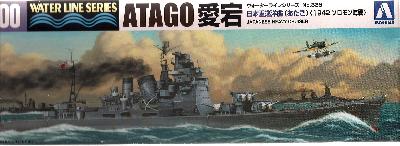Subtotal : 0 €
- Home
- Plastic model kits
- IMPERIAL JAPANESE NAVY HEAVY CRUISER
IMPERIAL JAPANESE NAVY HEAVY CRUISER
Description
Atago was one of four "Takao-class" heavy cruisers, designed to be an improvement over the previous "Myōkō-class" design. These ships were fast, powerful, and heavily armed. The Takao-class ships were approved under the 1927 fiscal year budget as part of the Imperial Japanese Navy’s strategy of the Decisive Battle, and forming the backbone of a multipurpose long range strike force. Atago was built by the Kure Naval shipyards near Hiroshima, and—like all heavy cruisers—was named after a mountain: in this case Mount Atago, located outside of Kyoto. At the start of the Pacific War, Atago was the flagship of Vice Admiral Kondō Nobutake’s Cruiser Division 4, along with sister ships Maya, Chōkai, and Takao, and assigned to support the invasion of Malaya and the Philippines. From January-March 1942, Atago was based out of Palau, and was involved in operations to seize the oil-rich Dutch East Indies, participating in numerous combat operations, including the Battle of the Java Sea. After taking Vice Admiral Kondō on an inspection tour of Japan’s new possessions in the former Dutch East Indies, Atago returned to Yokosuka in April 1942, where she was assigned to the unsuccessful pursuit of Admiral William F. Halsey’s Task Group 16.2 (TG 16.2)after the Doolittle Raid on Tokyo. After a retrofit in April 1942 , Atago departed for the disastrous Battle of Midway, from which she returned unscathed. On 7 August 1942, Atago was reassigned south to Truk, from which it made numerous sorties in the defense of Guadalcanal through December. Atago also participated in the Battle of the Eastern Solomons (24 August), Battle of Santa Cruz Islands (26-27 October) and in the Second Naval Battle of Guadalcanal (15 November). On 25 August, during the Battle of the Eastern Solomons, aircraft from the American aircraft carrier USS Wasp shot down two of Aichi E13A1 "Jake" floatplanes from Atago that were engaged in reconnaissance missions, killing all four aircrew members in the two aircraft. During the latter battle, in a night gun duel with the American battleships USS South Dakota and Washington, Atago and Takao hit South Dakota with seventeen 8 in (200 mm) rounds, five 6 in (150 mm) and one 5-inch. South Dakota was damaged, but not sunk. Atago was damaged slightly as a result of the action, and returned to Kure for repairs on 17 December. In January 1943, Atago returned to Truk to continue Japanese efforts to hold the Solomon Islands, and eventually to support the evacuation of Guadalcanal. She remained based out of Truk through July 1943, when she returned to Yokosuka for further refits and modifications. From August–November 1943, Atago returned to Truk to continue her sorties supporting Japanese forces in the Solomon Islands. In response to the Allied landings on Bougainville on 1 November 1943, Atago and several other Japanese cruisers were sent to Rabaul to prepare to attack the Allied landing forces. On 5 November, while refueling at Rabaul, Atago′s task force was attacked by 97 planes from the carriers USS Saratoga and Princeton. Atago sustained three near-misses by 500 lb (230 kg) bombs that killed 22 crewmen, including her skipper Captain Nakaoka who was hit by a bomb splinter while on the bridge. On 15 November, Atago returned to Yokosuka for repairs. In January 1944, Atago returned to Truk. On 10 February, the cruiser force was attacked by the American submarine USS Permit in a night surface attack, but she missed with four torpedoes. Atago was then reassigned to Cruiser Division 4 based in Palau under Vice Admiral Jisaburo Ozawa’s First Mobile Fleet. The cruiser force was unsuccessfully attacked by the submarine USS Dace on 6 April. From July-October 1944, Atago was flagship of Vice Admiral Takeo Kurita’s First Mobile Striking Force, the most powerful component of the Imperial Japanese Navy at the time with seven battleships, 11 heavy cruisers, two light cruisers, and 19 destroyers based at Lingga Roads near Singapore. On 22 October, in the Battle of Leyte Gulf, Atago sortied with Chōkai, Takao and Maya. The next day, during the Battle of the Palawan Passage, Atago was hit by four torpedoes fired by the submarine USS Darter, and set afire. At 05:53, Atago capsized in about 1,800 m (5,900 ft) of water at 09°28′N 117°17′E. Of Atago’s crewmen, 360 were killed, but 529 survivors including Vice Admiral Kurita, CoS Rear Admiral Tomiji Koyanagi and Atago’s skipper Rear Admiral Araki were rescued by Kishinami; 171 other survivors were also rescued by Asashimo. Atago’s sister ships fared no better: Maya was sunk by Dace; Takao was forced back to Brunei after being torpedoed by Darter (later scuttled after running onto a reef); and two days later, Chōkai was lost off Samar. (Scale : 1/700e)- Brand:
- AOSHIMA
- Scale:
- 1/700
- Ref:
- AOS045374
- Category:
- Plastic model kits




